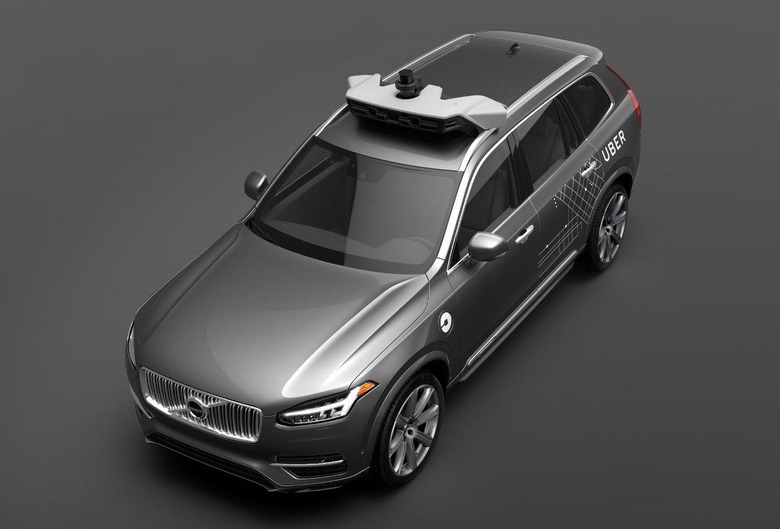Safety Driver In Fatal Autonomous Uber Crash Was Watching Hulu
The safety driver in Uber's autonomous car that killed a pedestrian in Tempe, Arizona earlier this year was watching Hulu on her phone right up to the crash, local police claim. The incident – which grounded Uber's self-driving car fleet as the company began an investigation into the safety of its vehicles – was "entirely avoidable" law enforcement have suggested.
The crash took place at night, with the autonomous Uber in self-driving mode at the time. A pedestrian pushing a bicycle walked into the road partway along a block between intersections, and the car failed to swerve or stop in time to avoid a collision. That pedestrian later died of her injuries.
At the wheel at the time, however, was Uber safety driver Rafaela Vasquez. Her role – a legally required one, as per the terms of Uber's autonomous testing permit in Arizona – was to monitor the car's behavior and be ready to step in should the vehicle fail to act safely or appropriately. However, footage provided by Uber from the car's internal cameras showed Vasquez repeatedly glancing down rather than looking at the road.
It prompted suspicions that the safety driver was otherwise occupied, and that led police to obtain records from Hulu, Reuters reports. Those records showed that Vasquez was streaming "The Voice" on the night of the crash, and was watching it until 9:59pm local time. That "coincides with the approximate time of the collision" a police report, obtained through a public records request, highlights.
Tempe Police Vehicular Crimes Unit is actively investigating
the details of this incident that occurred on March 18th. We will provide updated information regarding the investigation once it is available. pic.twitter.com/2dVP72TziQ— Tempe Police Department (@TempePolice) March 21, 2018
Had Vasquez been paying attention, the report argues, the crash was "deemed entirely avoidable." Uber's video shows the driver looking up a half second before the collision, having been looking down for 5.3 seconds. Given the speed of the car at the time, it could have traveled for more than 300 feet without Vasquez checking the road.
Vasquez "appears to react and show a smirk or laugh at various points during the times that she is looking down," the report suggests, finding that the safety driver "was distracted and looking down" for almost about 30-percent of the time in the nearly 22 minutes before the crash.
It conflicts with Vasquez's own claims from after the incident in mid-March. Then, she told investigators that neither her personal nor work phones had been in use at the time. An earlier report by the National Transportation Safety Board (NTSB) highlighted the fact that Uber had disabled its test car's native safety features. The Volvo XC90 SUV that Uber has been using for its autonomous trials in Arizona and elsewhere would, normally, rely on a system called City Safety that offers automatic emergency braking.
That promises to stop or significantly slow the SUV – depending on its speed at the time – if a pedestrian is spotted in the road ahead, even if the driver themselves doesn't hit the brakes. Uber, though, switched City Safety off, presumably to avoid it interfering with the car's prototype autonomous systems. Instead, the NTSB report highlighted, "the developmental self-driving system relies on an attentive operator to intervene if the system fails to perform appropriately during testing."

Meanwhile, at the time at least, the car did not have emergency braking maneuvering abilities of its own. Uber says that is "to reduce the potential for erratic vehicle behavior." The safety driver is responsible for seeing warning messages the car displays and reacting accordingly; the NTSB says the self-driving system spotted an emergency braking maneuver was needed "at 1.3 seconds before impact" but that it had been informed by Uber that its system was "not designed to alert the operator" in an emergency braking situation.
Elaine Herzberg, the pedestrian killed in the incident, was faulted for "unlawfully crossing the road at a location other than a marked crosswalk" in the police report. Vasquez, meanwhile, could face vehicular manslaughter charges. County prosecutors will decide, based on the police evidence, whether to take that path.
For Uber, the plan is still apparently to restart autonomous testing later this summer. That won't be in Arizona, however. Instead, the ridesharing firm confirmed, it will focus on trials in San Francisco and Pittsburgh, closer to its engineering hubs where software and hardware work on the car systems is being undertaken.
